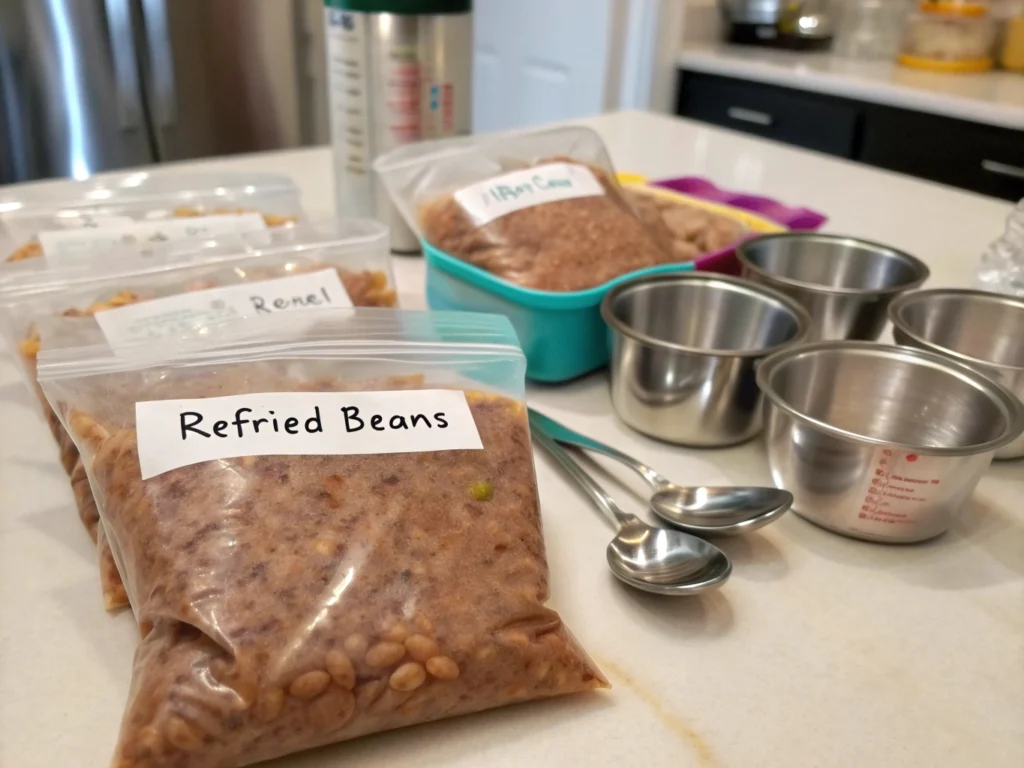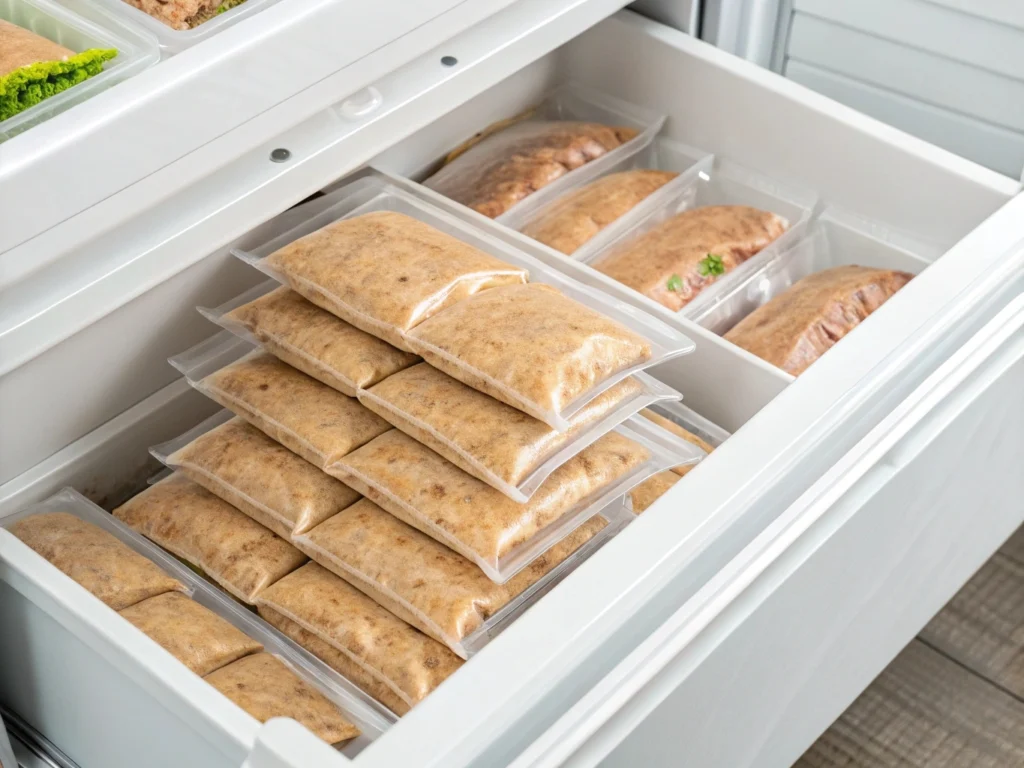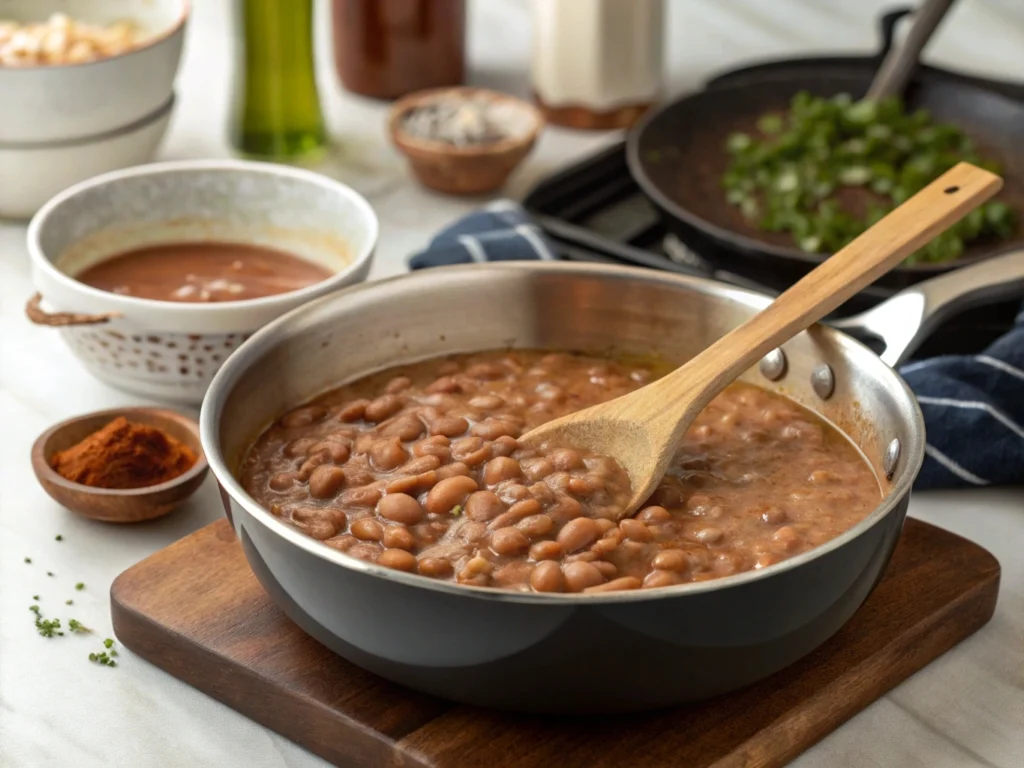Love the taste and versatility of refried beans, but often have too many leftovers? You’re not alone! Instead of letting them go to waste, the answer is to freeze them. But can you freeze refried beans without sacrificing their taste and texture? Absolutely yes! This comprehensive guide will show you exactly how to freeze refried beans safely, helping you preserve their quality and make mealtime much more convenient.
Table of Contents
How to Freeze Refried Beans Safely: The Ultimate Guide for Delicious Results
Freezing refried beans is a total game-changer for busy weeknights and those spontaneous taco cravings! But to keep that perfect creamy texture and mouthwatering flavor, a little prep work is essential. This guide will walk you through the best ways to prepare your beans for the freezer without sacrificing quality because we all deserve refried beans that taste amazing every time. Learn how to freeze refried beans like a pro!
Cool it Down: Why It’s Key Before Freezing
Before you even think about putting those delicious refried beans in the freezer, they need to be completely cool. Freezing hot refried beans leads to condensation, creating ice crystals and dreaded freezer burn. Freezer burn is a big no-no; it ruins the appearance, taste, and texture, making your beans less enjoyable.
- Quick Tip: After cooking or purchasing, let them sit uncovered on the counter for about 20-30 minutes. A shallow dish helps them cool faster. Think of it as giving your beans a little time to relax before their icy adventure. This step is crucial for maintaining that restaurant-quality creamy texture everyone loves.
Portion Control: The Secret to Quick Meals
While you could freeze refried beans in one big block, it’s not practical for most people. Freezing in individual portions is the way to go, ensuring super-easy reheating and no food waste.

- How to Portion: Use a ½ cup or 1 cup measuring cup or an ice cream scoop. Create single-serving sizes to simplify future meals.
- Container Prep: Place each portion in separate, freezer-safe bags or containers. Now you’re ready to grab just what you need for a quick taco Tuesday, a dollop on your favorite nachos, or a side dish for your next Tex-Mex meal.
The goal is simple: save time and prevent thawing an entire batch when you only need a little. By portioning, you make your future self very happy.
Choosing the Right Freezer Containers: The Key to Success
Selecting the right storage containers is crucial for freezing refried beans successfully. Here are your top choices:
- Freezer-Safe Ziploc Bags: These are perfect for saving space in your freezer. After filling, flatten the bags for easy stacking. Imagine them as your personal refried bean storage Tetris. They’re also fantastic for freezing refried beans in bulk.
- Airtight Containers: These reusable containers are an excellent, eco-friendly option. Ensure they’re specifically labeled “freezer-safe” to prevent cracking in low temperatures.
- Pro Tip Alert: Always leave about ½ inch of headspace at the top of your containers. This space allows for expansion as the beans freeze, preventing the lid from popping off or the bag from bursting. It’s like an insurance policy for your frozen food.
- Bonus Tip: Use silicone muffin tins to create individual “bean pucks.” Freeze these before transferring to a freezer bag to use them one at a time!
Food Safety First: For detailed information on safely freezing food, check out this guide from the USDA.
Air: The Enemy of Delicious Frozen Food – Remove It!
Air exposure is the leading cause of freezer burn and those unwanted off-flavors. After placing your refried beans in a Ziploc bag or container:
- Squeeze It Out: Gently press out as much air as possible before sealing the bag. Think of it as giving your beans a mini massage to remove all that extra air. This helps maintain the best flavor and quality.
- Vacuum Sealer Advantage: If you have a vacuum sealer, now’s the time to use it! It provides the ultimate protection against air, ensuring your beans will taste fantastic for months.
These steps are essential for keeping your refried beans fresh and flavorful for up to three months in the freezer. This ensures you are preserving the quality of frozen refried beans.
Freezing refried beans properly isn’t hard, but attention to detail is essential. By following these easy tips, you’ll enjoy beans that taste just as great as the day they were made. Next, we’ll cover packaging, common mistakes to avoid and how to defrost your frozen refried beans perfectly so that you know how to use your frozen leftover refried beans.
Packaging Methods: The Key to Fresh and Flavorful Frozen Refried Beans
Proper packaging is essential when freezing refried beans – it’s the secret weapon for maintaining their delicious flavor, creamy texture, and overall quality. The right approach helps prevent freezer burn, keeps your beans fresh, and makes reheating a breeze. Follow these packaging tips to get the best results and enjoy perfectly frozen leftover refried beans.

Freezer-Safe Ziploc Bags: A Space-Saving Solution
Freezer-safe Ziploc bags are a popular choice for freezing refried beans, especially when you need to save space. These bags create a strong barrier against air, which is key for preventing freezer burn. Here’s how to package your beans in Ziploc bags:
- Scoop and Fill: Spoon your cooled refried beans into the bag, leaving a little room at the top.
- Flatten and Squeeze: Gently flatten the bag as much as possible to remove excess air. Use your hands or a rolling pin for this.
- Seal and Label: Seal the bag tightly, and don’t forget to label it with the date and contents.
- Space Savers: Flattening the bags makes them easy to stack in your freezer, saving precious space and allowing them to freeze evenly. This also helps you quickly grab the portion you need without thawing everything.
This method is fantastic for freezing refried beans in bulk.
Airtight Containers: Reusable and Reliable
If you’re looking for reusable options, airtight containers are an ideal choice for freezing refried beans. They offer robust protection against moisture and freezer burn. Keep in mind they will take up more space than bags, so you will need to consider how you organize your freezer.
- Choose the Right Size: Select a container that matches your portion of beans.
- Leave Room for Expansion: Make sure to leave a small gap at the top (about ½ inch) to allow for expansion during freezing.
- Seal Securely: Snap the lid on tightly to lock out air, creating an airtight seal.
- Microwave-Safe Bonus: For extra convenience, choose containers that are also microwave-safe for easy reheating of your frozen refried beans.
Double Wrapping: Extra Protection for Long-Term Storage
For long-term storage or extra protection, double wrapping is the way to go when freezing refried beans. This involves wrapping your filled Ziploc bag or container in aluminum foil.
- Insulation Boost: The extra layer of foil insulates the beans from temperature fluctuations.
- Long-Term Preservation: Double wrapping is especially useful if you plan to store the beans for more than two months, offering even better protection against freezer burn.
Double wrapping is the secret weapon to ensure that your frozen refried beans maintain their original flavor and creamy consistency, even after weeks in the freezer.
Labeling and Organization: Keeping Your Freezer in Order
To avoid confusion and maintain a well-organized freezer, always label your refried beans packages with key details, such as:
- Contents: (e.g., “Refried Beans,” “Spicy Refried Beans”).
- Date Frozen: This is crucial to track their freshness.
- Portion Size: (e.g., “1 cup,” “2 servings”).
- Bonus tip: Use colored labels to categorize beans with different spices and flavors.
Make sure to follow the FIFO rule by placing newer packages at the back of the freezer and older ones at the front. This simple trick ensures that you use the older batches first, reducing waste and keeping your freezer organized. It is best if you place them in a visible and easy-to-access place.
Proper packaging methods make all the difference in answering the question, “Can you freeze refried beans and still enjoy them later?” By following these practical tips, you can be confident that your beans will be as delicious and satisfying as the day you made them. Up next, we’ll explore the differences between freezing homemade and store-bought beans.
Freezing Homemade vs. Store-Bought Refried Beans: Which is Best?
When it comes to freezing refried beans, there are notable differences between homemade and store-bought varieties. While both can be frozen successfully, understanding their unique characteristics can help you decide which approach is best for your needs and preferences. This guide will help you make the right choice when freezing leftover refried beans.
Freezing Homemade Refried Beans: Freshness and Control
Homemade refried beans are typically fresher and free from preservatives, making them a fantastic choice for freezing. These beans tend to freeze and reheat beautifully when prepared and stored correctly. Freezing homemade refried beans is a great way to have delicious and versatile food ready for quick meals.
Here’s what makes homemade beans an excellent choice for freezing:
- Customizable Ingredients: You have full control over the seasonings, oil, or fat content, tailoring them to your specific taste.
- Flavorful Add-Ins: Ingredients like onions, garlic, or jalapeños blend perfectly and retain their flavors after freezing and reheating.
- Example: If you’ve made a batch of delicious vegetarian refried beans from scratch, you’ll find they maintain their creamy texture after freezing and reheating if you follow the proper freezing and packaging steps we mentioned earlier. This way you avoid flavor loss.
If you’re planning to freeze leftover refried beans, it’s essential to follow proper storage practices to maintain their quality and safety. Similarly, learn the best ways to store and extend the shelf life of other leftovers like rotisserie chicken.
Freezing Store-Bought Refried Beans: Convenience is Key
The common question, “Can you freeze refried beans from a can?”, is often asked. The answer is yes! Freezing store-bought refried beans is very convenient, although it may require a little extra care. Since canned refried beans are pre-cooked and may contain preservatives, their texture may be slightly different after freezing. However, with some simple steps, you can make them delicious even after being frozen.
Here are the steps to successfully freeze store-bought beans:
- Transfer to Freezer-Safe Container: Immediately transfer the beans from the can to a freezer-safe container or bag.
- Stir for Even Texture: Stir the beans thoroughly to ensure an even texture before freezing.
- Add a Splash of Liquid: Add a small splash of water or broth to help them retain their moisture during the reheating process.
While freezing store-bought refried beans is a quick and easy option, it’s good to know that homemade refried beans generally offer more flexibility and flavor control.
Taste and Texture Comparison After Freezing
A key difference between the two options lies in their taste and texture after being frozen and thawed:

- Homemade Refried Beans: These beans often retain a smoother, richer flavor and a more creamy texture because of the fresh ingredients. They are less likely to suffer from flavor loss since you have control over what goes in them.
- Store-Bought Refried Beans: These might develop a slightly more grainy texture after freezing due to stabilizers used in canned products. However, this can be easily remedied by adding a little extra liquid when reheating, which will bring back their desired creaminess.
Regardless of these slight differences, both options are still delicious and serve as a convenient meal or side dish.
Which Refried Beans Should You Freeze?
Ultimately, the choice depends on your needs and priorities. If you prioritize maximum control over taste and ingredients, homemade refried beans are the way to go for freezing leftover refried beans. However, if convenience is your priority, store-bought refried beans freeze well with minimal effort.
- Pro Tip: If you have leftover canned beans, it’s best to freeze them immediately after opening to keep them as fresh as possible.
- Ready to make your own? Check out our other posts for delicious refried bean recipes and more freezer-friendly kitchen tips!
Defrosting and Reheating Frozen Refried Beans: The Secret to Delicious Results
Properly defrosting and reheating frozen refried beans is essential to preserving their delicious flavor, creamy texture, and overall consistency. When done right, your refried beans will taste just as amazing as the day you made or bought them. Let’s explore the best methods to ensure you get the most out of your frozen leftover refried beans.

Thawing in the Refrigerator: The Safest Approach
The safest and most reliable method to defrost your frozen refried beans is by transferring them from the freezer to the refrigerator. This process allows the beans to thaw gradually, maintaining their original quality and preventing any potential safety issues.
- Timeframe: Plan for about 8-12 hours of defrosting in the fridge, depending on your portion size.
- Step-by-Step: Place the sealed container or bag on a plate to catch any condensation or leaks.
This method is ideal for meal prep because you can simply move the beans into the fridge the night before you need them. While it takes longer, it ensures even thawing and significantly reduces any risk of food safety concerns, keeping your frozen refried beans tasting fresh.
Microwave Defrosting: A Quick Solution
If you’re pressed for time, a microwave can be used to defrost your frozen refried beans quickly. However, it’s important to proceed carefully to prevent overheating or an uneven texture.
- Instructions: Place the beans in a microwave-safe container with the lid slightly ajar. Use the microwave’s defrost setting or heat in 30-second intervals, stirring between each interval.
- Moisture Boost: Add a splash of water or broth to help restore the beans’ smooth texture during reheating. This is particularly helpful for maintaining the creamy consistency you love.
While this method is fast and convenient, be mindful not to overheat the beans, as this can alter their taste and texture. Check frequently and add liquid if needed.
Stovetop Reheating: For the Best Creamy Texture
Reheating frozen refried beans on the stovetop is often the most effective way to bring back their creamy, smooth consistency. This method allows for even heat distribution and lets you control the moisture level.
- Transfer to a Pan: Move the defrosted beans to a saucepan.
- Heat Slowly: Heat over low to medium heat, stirring frequently to prevent burning.
- Adjust Consistency: Add a small amount of water, broth, or oil to adjust the consistency as needed, bringing them back to their desired texture.
- Example: If the beans seem too thick after thawing, a tablespoon of broth will work wonders to loosen them up. This method is perfect for larger portions because it ensures even heating throughout.
Common Reheating Mistakes to Avoid
While reheating is generally straightforward, a few common mistakes can negatively impact the final result of your frozen refried beans:
- Skipping Stirring: Always stir the beans frequently to prevent them from sticking to the pan or drying out, which can ruin their texture.
- Reheating at High Heat: Use low to medium heat when using the microwave or stovetop to avoid scorching the beans. This is crucial for keeping their flavor intact.
- Not Adding Moisture: Frozen refried beans may lose some liquid during freezing, so adding a little water or broth is essential for bringing back their desired texture.
Avoiding Common Mistakes When Freezing Refried Beans: A Guide to Success
While freezing refried beans is a relatively simple process, certain missteps can negatively affect their flavor, texture, and how long they last. By understanding and avoiding these common mistakes, you’ll ensure that your frozen refried beans remain delicious and ready to enjoy whenever you need a quick and satisfying meal. This guide will help you achieve perfect results every time.
Freezing Large Batches Without Portioning: A Recipe for Waste
One of the most common mistakes when freezing refried beans is freezing them in large, unmanageable blocks. While it may seem convenient in the moment, thawing an entire batch when you only need a small amount often leads to food waste.
- Why Portioning Matters: Smaller, individual portions are much easier to thaw and reheat, allowing you to use just what you need for a specific meal or side dish.
- The Solution: Use freezer-safe Ziploc bags or containers to divide your refried beans into single-serving sizes. Flatten the bags for quicker defrosting and more efficient storage.
Example: If you often use refried beans for tacos, burritos, or nachos, freezing them in ½ cup or 1-cup portions is a practical and efficient approach. This helps you use only what you need and prevents excess food waste.
Failing to Remove Excess Air: The Enemy of Frozen Food
Air exposure is a leading cause of freezer burn, which can make your frozen refried beans taste bland, grainy, or just plain off. Luckily, this is entirely avoidable with proper packaging techniques.
- Impact of Freezer Burn: Freezer burn dries out the beans and drastically alters their desirable creamy texture, making them far less appealing.
- The Fix: Squeeze out as much air as possible from your freezer-safe Ziploc bags before sealing. For optimal results, use a vacuum sealer if you have one, as it provides superior protection.
Example: If you’re using reusable containers, pressing a sheet of plastic wrap directly onto the surface of the beans before sealing the lid will help minimize air contact. This extra step can make a huge difference.
Skipping Proper Labeling: A Recipe for Freezer Chaos
Another easily overlooked mistake when freezing refried beans is forgetting to label your packages. Without clear labels, it’s easy to forget when they were frozen and you won’t know how long they are good for.
- Why It’s Important: Labeling helps you track how long your beans have been in the freezer. Refried beans generally stay fresh for up to three months when frozen correctly.
- Pro Tip: Include the freezing date, portion size, and any special seasoning notes on the label. This will also help you quickly grab the right batch for your recipe.
This simple, yet crucial step, not only saves you time but also prevents perfectly good food from being discarded prematurely.
Not Adding Moisture During Reheating: The Key to Creaminess
Once frozen refried beans are defrosted, they may often appear thicker or drier than when they were fresh. This is simply because some of the moisture is lost during the freezing process.
- Common Mistake: Reheating the beans without adding extra liquid can result in a dense, and unappetizing texture, losing the creaminess you desire.
- The Solution: Stir in a small amount of water, broth, or even a splash of olive oil while reheating. This will help them regain their original smooth consistency.
Example: A tablespoon or two of vegetable broth can work wonders to bring your beans back to their silky smooth texture, ensuring they taste just as delicious as when they were freshly made.
FAQs: Your Burning Questions About Freezing Refried Beans Answered
This section addresses the most frequently asked questions about freezing refried beans, providing clear and concise answers to help you confidently navigate the process. From storage to thawing, we’ve got you covered so that you always have delicious frozen refried beans on hand.
Will Refried Beans Freeze Well?
Yes, refried beans freeze very well when stored properly. Their creamy texture and rich flavor will remain intact as long as you follow the correct freezing techniques outlined in this guide. To achieve the best results when freezing leftover refried beans, always portion them, use airtight containers or freezer-safe bags, and remove as much air as possible before sealing. This way, your frozen refried beans can stay fresh and delicious for up to three months.
Can You Freeze Refried Beans in Ziploc Bags?
Absolutely! Freezer-safe Ziploc bags are one of the best and most convenient options for freezing refried beans. They save valuable freezer space, are easy to label, and make defrosting a breeze. To successfully freeze refried beans in Ziploc bags:
- Let the beans cool completely to room temperature.
- Portion them into convenient serving sizes.
- Place the portions into the bags, flatten them to remove excess air, and seal tightly.
By flattening the bags, you not only optimize freezer space, but you also ensure that the frozen refried beans thaw evenly when you’re ready to use them. This is one of the best methods for freezing refried beans in bulk.
How Do You Defrost Frozen Refried Beans?
Defrosting frozen refried beans is quite simple and can be done in a few different ways, depending on your timeline and preferences:
- In the Refrigerator: Transfer the frozen refried beans to the refrigerator and let them thaw overnight. This method is best for preserving their delicate flavor and creamy texture.
- Using a Microwave: For a faster option, use the defrost setting on your microwave, heating in short intervals and stirring in between. Add a little liquid if needed.
- On the Stovetop: If you’re short on time, gently heat the frozen refried beans in a pan over low heat with a splash of water or broth to restore their smooth texture.
Whichever method you choose, avoid refreezing defrosted refried beans to maintain their quality and prevent any food safety issues.
Can You Freeze Canned Beans After They Are Opened?
Yes, you can absolutely freeze canned refried beans after opening the can. However, it’s important to transfer the canned refried beans to a freezer-safe container or Ziploc bag before freezing. Leaving the beans in the can is not recommended, as the can may warp, crack, or corrode in the freezer, altering the quality of the beans.
For the best results when freezing leftover refried beans:
- Stir the beans gently to evenly distribute any oils or seasonings.
- Portion them into freezer-safe containers or bags.
- Label each batch and freeze for up to three months.
Freezing leftover canned refried beans is an easy and practical way to extend their shelf life and reduce food waste, keeping your kitchen organized and efficient.
Conclusion: Enjoy Delicious Refried Beans Anytime!
Can you freeze refried beans? Absolutely! It’s a fantastic way to save time, money, and minimize waste, while always having your favorite side dish readily available. By following the comprehensive tips outlined in this guide, you can rest assured that your refried beans will retain their delicious taste and creamy texture even after being frozen.
From portioning your beans to selecting the right storage method, each step plays a vital role in maintaining their quality and flavor. Whether you prefer homemade refried beans for their fresh, customizable taste or store-bought refried beans for convenience, freezing them properly ensures they’re always ready to be enjoyed whenever you need a quick and delicious meal.
Remember, defrosting and reheating require just a little extra care to bring your beans back to life, making them taste as good as the day you made or opened them. By avoiding the common mistakes, and following the best practices shared here, you’ll be able to enjoy perfectly frozen refried beans every time.
Try freezing your refried beans today, and let us know how it worked for you in the comments below! For more helpful kitchen tips, tricks, and recipes, explore our blog and discover new ways to make mealtime even easier and more enjoyable.

